

|
Well this morning the thermometer says -2C and I haven’t gone any further outside than getting the paper from the front porch. Maybe the geraniums on the front steps will finally have been killed. They certainly haven’t looked very well for the past couple of week but there hadn’t been a hard enough frost to do them in. I love my garden but when it’s time, it’s time. I have most of the necessary garden cleanup accomplished. There is lots more I could do and hopefully will but nothing that would be a disaster if it waited until spring. 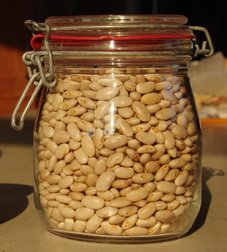 Dual Purpose Beans. I did make a wonderful discovery during the cleanup process. I was frequently absent from the garden this summer and as a result several things didn’t happen. We didn’t eat nearly as many beans as I had planted. When I was tearing down the vines and strings from the pole bean trellises, I discovered a large quantity of dried pods. Started to shell them and wound up with a considerable quantity of dried beans. A little research showed me that there are many types of pole beans that home gardeners use for dried beans. Searching for the perfect recipes now and will publish any that I like to my recipe section. By the way, I always use jute string for my pole beans because it is also compostable and I don’t have to try and separate the vines and strings. Just another lazy gardener’s tip.
Dual Purpose Beans. I did make a wonderful discovery during the cleanup process. I was frequently absent from the garden this summer and as a result several things didn’t happen. We didn’t eat nearly as many beans as I had planted. When I was tearing down the vines and strings from the pole bean trellises, I discovered a large quantity of dried pods. Started to shell them and wound up with a considerable quantity of dried beans. A little research showed me that there are many types of pole beans that home gardeners use for dried beans. Searching for the perfect recipes now and will publish any that I like to my recipe section. By the way, I always use jute string for my pole beans because it is also compostable and I don’t have to try and separate the vines and strings. Just another lazy gardener’s tip.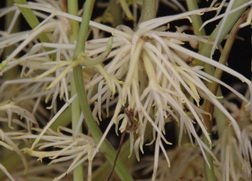 Test Your Garden Knowledge. Just how lazy can a gardener be?? Here’s a bit of a contest and the correct answer will give you some idea. Identify this picture and you could win something valuable from my garden, (maybe some Iris rhizomes,) and everyone will find out just how slow I can be at getting some gardening chores completed.
Test Your Garden Knowledge. Just how lazy can a gardener be?? Here’s a bit of a contest and the correct answer will give you some idea. Identify this picture and you could win something valuable from my garden, (maybe some Iris rhizomes,) and everyone will find out just how slow I can be at getting some gardening chores completed.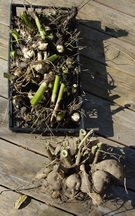
Dahlia Storage. The recent lighter frosts certainly took the tops off the Dahlias and Cannas. These two are some of the few things that I bother to dig up and keep from year to year. It’s simple to do and they store quite easily and that saves me a lot of money in the spring. Just cut the blackened tops off and dig up the roots, properly called tubers for Dahlias and Rhizomes for the Cannas. Stick your fork in the ground a good distance away from the growing points and work your way in so that you don’t drive the tine of the fork through the flesh of these roots. Remove as much soil as you readily can and then let them dry for a few days in a warm sunny spot. More of the soil should now come away easily. Store them in a cool, 10C, 50F, dark spot covered with some barely damp peat moss. Same process for the tuberous begonias. 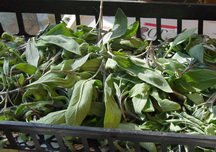 Harvest Time Is Messy. The entire solarium and kitchen is a complete mess at this time of year. Harvested potatoes and onions are waiting to be sorted and moved to the basement. Any potatoes that are bruised or cut by the fork are separated and stored in the fridge to be used first so they don’t start to rot in the storage bins. Trays of fresh herbs such as the Sage in the picture, are drying so that they can be chopped and stored for the winter. The mint is best stored as mint sauce but that’s just not going to happen this year. It’s now obvious that the large Wildfire Begonia is not going to survive and regrow and maybe today I will get it off the counter and into the compost.
Harvest Time Is Messy. The entire solarium and kitchen is a complete mess at this time of year. Harvested potatoes and onions are waiting to be sorted and moved to the basement. Any potatoes that are bruised or cut by the fork are separated and stored in the fridge to be used first so they don’t start to rot in the storage bins. Trays of fresh herbs such as the Sage in the picture, are drying so that they can be chopped and stored for the winter. The mint is best stored as mint sauce but that’s just not going to happen this year. It’s now obvious that the large Wildfire Begonia is not going to survive and regrow and maybe today I will get it off the counter and into the compost. 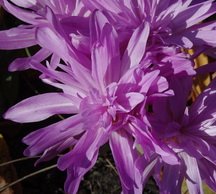 Always Fresh Surprises. I planted several new Colchicum this fall and they are continuing to delight me with their large pink flowers and even this frost should not stop them. It’s a delight to have new fresh flowers blooming at this time of year. The Autumn Crocus are still quite prolific in the Asparagus beds and there are a few bright yellow Sternbergia blooming around the lower pond. The fascinating thing is the Colchicum. All of the bulbs came from the same box and some of them are the normal large single flowers but some of them have large double flowers on shorter stems, as in the picture??????? Colchicine, a chemical derived from this plant has long been used by plant breeders to induce mutations in a wide variety of plants. Hmmm???
Always Fresh Surprises. I planted several new Colchicum this fall and they are continuing to delight me with their large pink flowers and even this frost should not stop them. It’s a delight to have new fresh flowers blooming at this time of year. The Autumn Crocus are still quite prolific in the Asparagus beds and there are a few bright yellow Sternbergia blooming around the lower pond. The fascinating thing is the Colchicum. All of the bulbs came from the same box and some of them are the normal large single flowers but some of them have large double flowers on shorter stems, as in the picture??????? Colchicine, a chemical derived from this plant has long been used by plant breeders to induce mutations in a wide variety of plants. Hmmm???Questions My newsletter subscribers get to ask me questions. Just ‘reply’ to the email newsletter. It is always interesting to read the questions; mostly to see if I actually can answer them or if I have to wade into the textbooks to research the answers. If that happens then we all learn something. Stanley Asks? The leaves on my Water Lilies are still looking reasonable what should I do with them? Ken Answers! You should remove them before the pond freezes over. They will sink to the bottom of the pond and add to the accumulation of rotting sludge down there. In a natural pond they add to the rich soil that supports the plant growth but that’s not as desirable in your small backyard ponds. I have a wonderful pair of long handled pruners that allow me to get to the bottom of the Lily stems and cut them off without reaching too far into the rather cold water. Cut any other pond foliage off as low as possible as well. 111 Trent St. W. Whitby ON L1N1L9 |
